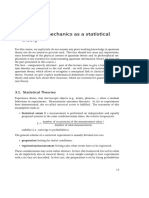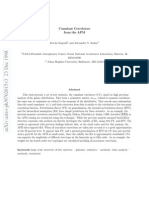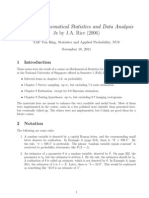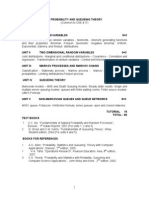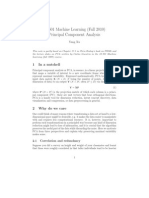Modeling Input/Output Data: Partial Least Squares (PLS)
Modeling Input/Output Data: Partial Least Squares (PLS)
Uploaded by
Kerwin ManiaulCopyright:
Available Formats
Modeling Input/Output Data: Partial Least Squares (PLS)
Modeling Input/Output Data: Partial Least Squares (PLS)
Uploaded by
Kerwin ManiaulOriginal Title
Copyright
Available Formats
Share this document
Did you find this document useful?
Is this content inappropriate?
Copyright:
Available Formats
Modeling Input/Output Data: Partial Least Squares (PLS)
Modeling Input/Output Data: Partial Least Squares (PLS)
Uploaded by
Kerwin ManiaulCopyright:
Available Formats
Lecture 6:
Modeling Input/Output Data: Partial Least Squares (PLS)
c It was shown in the previous chapter that a few simple concepts from linear algebra opened up a world of ideas on how to look at real laboratory data. In this lecture we pursue this further. In Lecture 3, using the method of least squares (linear regression), we dealt with the case of an over determined system of linear equations. At the time it was pointed out that, given enough data, i.e., input/output data we could use least squares to determine an assumed linear relation between these, i.e., the matrix relating these. Specically suppose a stimulus, s, and a response, r, with the relation
r = Ts
(6.1)
with dim(r) = n and dim(s) = m then T has n m unknowns. In principle we can envision linearly independent stimuli {sj } j = 1, ..., M , with corresponding responses {rj } so that
R = TS with R= and S= It then follows that s1 s2 sm . r1 r2 rm
(6.2)
(6.3)
(6.4)
T = RS1 .
(6.5)
99
100
Lecture 6: Modeling Input/Output Data: Partial Least Squares (PLS)
In a real experiment noise is an issue, as is the nature and quality of the relation of input to output. This lecture will deal with these questions in a larger framework.
Determining T, the coecient matrix in (6.5), has more than one perspective. If one dons the mask of a theoretician, the obvious choice for sk is sk = [0, ..., 0, sk , 0, ..., 0] , i.e., zeros except at the kth entry. This leads to the evaluation of the kth column of T at each of the m experiments k = 1, ..., m. On the other hand the experimenter is likely to repeat the same experiment, and as a result the dierence in s & r are due to noise. Within this framework the system is being explored by noise. This is a legitimate procedure but carries with it the need for a (very) large number of repeats. Another feature deserves menton. In the example to be introduced next we consider the inuence of tissue qualities (input) on malignancy (output). The latter is coded as +1 for cancer, and 1 for non-malignancy. This represents a lumping, or coarse-graining on the description which is inherited by T. If the outcome could be rened by say the degree and quality of the malignancy, a more rened model would result.
Linearity To give substance to these ideas consider Table 6.1 which shows protein microarray data of lung tissue cell lines showing 15 biomarkers, as collected from lung tissue and Mesothelium, a lung membrane. Results are shown for both malignant and normal tissue. Protein levels represent input and malignancy/non-malignancy the output.
Table 6.1:
Protein biomarkers at left. In total there are 6 malignant and 3 non-
malignant assays, all of which are represented as columns in the Table. Thus nine experiments in all.
Exercise 6.1. Download smalldata.xls from the website, which yields Table 6.1. (a) Merge the non-malignant data matrix and perform SVD on it. How many signicant components?
Lecture 6: Modeling Input/Output Data: Partial Least Squares (PLS)
101
(b) Same for the malignant data. We rst comment on the suitability of the assumption of linearity. For purposes of exposition imagine an input/ouput
1
relation of the general form
r = F(s).
(6.6)
At this stage in our thinking we imagine this as laboratory data in the form of a table. Suppose the input s is p dimensional and the output r is n dimensional. In the neighborhood of some operating point of interest, (r0 , s0 ),
r0 = F(s0 ),
(6.7)
then there should be some range over which a linear approximation, given by a two-term Taylor expansion, F s F s
y = r r0 =
s0
(s s0 ) =
x
s0
(6.8)
is valid. This should provide a reasonable description of the input/output behavior over the same range. Further discussion of such an approach will be facilitated by reformatting the problem. First dene F s
B = in which terms (6.8) can be written as
(6.9)
s0
y = x B,
(6.10)
where the output, y , is an n dimensional row vector, the input, x a n dimensional row vector and B is a p n matrix. The challenge to modeling the data, in input/output form, is then to determine B. As will be seen the reference points, zero subscripts, might be taken to be average values. To give this some perspective suppose (6.6) is a scalar equation, i.e., the experiment produces one (scalar) output y, from a vector input so that instead of (6.10) we would write
y =xb
(6.11)
to emphasize that (6.9) in this case is a vector, of order p, rather than a matrix. Clearly, many experiments are needed (> p) in order to determine the components of the vector b, followed by an appropriate regression analysis.
1
Other equivalents are: stimulus/response, predictor/resultant and so forth.
102
Lecture 6: Modeling Input/Output Data: Partial Least Squares (PLS)
Returning to the general case, (6.10), we can assemble many, say N , experiments, as rows of an N n matrix, Y, and each of the inputs as rows of the N p matrix, X, y1 y2 Y= . . . yN so (6.10) becomes x1 x2 & X= . , . . xN
(6.12)
Y = XB.
(6.13)
Recalling our discussion of the similar case in Lecture 3 we might then consider a least squares t (6.13) which yields
B = (X X)1 X Y and if (X X) is not full rank we can determine the Moore-Penrose inverse X+ = pinv(X) so that B = X+ Y.
(6.14)
(6.15)
To illustrate with the data of Figure 6.1 we merge all the data and therefore each column represents an experiment, and appears as a row of protein assays in 0.93 1.51 1.19 0.03 0.02 0.27 0.06 0.00 0.12 0.00 0.12 0.52 0.00 0.12 0.00
1.16 2.07 1.79 1.16 0.09 0.02 0.69 0.03 0.24 0.05 0.16 0.40 0.03 0.86 0.01 0.68 1.67 1.25 0.34 0.25 0.71 0.66 0.00 0.41 0.00 0.23 0.71 0.00 0.60 0.00 1.08 2.04 1.36 0.59 0.506 1 0.64 0.03 0.26 0.07 0.05 0.19 0.01 0.01 0.075 X = 1.01 1.64 1.54 0.04 0.79 0.13 0.31 0.00 0.88 0.00 0.23 0.37 0.00 0.25 0.03 . 0.88 2.01 1.74 0.31 0.99 0.02 1.34 0.09 0.25 0.02 0.01 0.20 0.04 0.46 0.04 0.54 4.61 4.87 0.00 0.00 0.17 2.85 0.49 1.09 0.29 2.87 7.47 0.87 3.79 0.32 0.12 5.38 4.32 0.28 0.2 0.35 2.43 0.16 0.91 0.48 0.89 5.62 0.27 1.26 0.72 0.21 3.14 2.28 0.10 0.363 0.00 1.25 0.11 1.02 0.17 0.73 2.68 0.32 1.08 0.40 The output is the presence or absence of malignancy. This we might express as
(6.16)
Y1 = 1 1 1 1 1 1 1 1 1 or equivalently as
(6.17)
Lecture 6: Modeling Input/Output Data: Partial Least Squares (PLS)
103
Y2 = Moore-Penrose(Pseudo) Inverse 111100110 000011001
. (6.18)
This is an opportune time to reconsider the Moore-Penrose inverse since it is easily understood within the framework of SVD. Suppose X is N M and has the SVD X = UV =
N j=1 uj j vj
(6.19)
with uj & vj the orthonormal column of U & V, respectively, and j the elements of the diagonal matrix . Then the Moore-Penrose inverse X+ is given by X+ = where 0; j = 0 j = 1/ ; = 0 j j Observe
N j=1 N j=1
vj , u j
(6.20)
(6.21)
X+ X = is the identity matrix in a restricted space. Exercise 6.2. Show 1. XX+ X = X 2. X+ XX+ = X+ 3. (XX+ ) = XX+ 4. (X+ X) = X+ X
vj u j
(6.22)
Exercise 6.3. For (6.16) and (6.17) the model is a scalar
y = x b
(6.23)
Use the Moore-Penrose inverse to nd b. How well does this reproduce (6.17)? From SVD of X in this case what are the s? Do you see a problem?
104
Lecture 6: Modeling Input/Output Data: Partial Least Squares (PLS)
As will become clear the discussion leading to (6.14) or (6.15) is purely formal. It does not address a number of underlying issues that accompany this approach, or for that matter any general discussion of data modeling. We enumerate some of the issues: (1) One might for example think of using SVD to decompose both Y and X, but these lead to representations in formally unrelated spaces, and there is no direct way to link these. (2) In constructing Y, we assemble what we regard as a reasonable collection of responses (observations) but there might be some redundancy. (3) In assembling X, the input, or predictors, we face the same problem. In addition we might be recording input that is uncorrelated with what is deemed to be the appropriate output. Observation: An attractive idea is that we try to nd a way which exploits the correlation between input and output. (4) The units of both Y and X can be an issue. To see this suppose voltage and temperature are recorded output variables. Clearly, these carry dierent units, and for each what units should we use? If we use microvolts instead of volts, a factor of 106 enters and gives a great weight to voltage. Even if the physical units are homogeneous, problems can appear. Imagine a biochemical soup with vastly dierent concentrations. Data preparation Item (4) addresses a general issue in dealing with data and can be taken care of by the following recipe: Normalize all data points by removing the mean, called centering, and then divide the result by the standard deviation. More specically if {xj }, j = 1, 2, ..N , denotes the elements of a column of X or Y, then form the mean, 1 N
N
x= and the variance 1 N
xj
j=1
(6.24)
2 = and redene the input/output as
N j=1
(xj x)2
(6.25)
zj =
xj x .
(6.26)
The last is called the Z-score of the measurements, it is zscore in Matlab, and puts all columns of X on an equal footing, and similarly for Y. Observe that this recipe centers all the data, confers unit variance on these and in doing this eliminates physical units.
Lecture 6: Modeling Input/Output Data: Partial Least Squares (PLS)
105
On a cautionary note it should be noted that for the Rogues Gallery problem, the data is composed of images, and in particular the gray levels at pixels. If the gray levels at each pixel are transformed to Z-scores, to some degree we might lose the information that the placement of pixels carries information. Exercise 6.4 (Optional). Subject the male population ensemble to the Z-score transformation. Calculate eigenfaces and spectra accordingly. After undoing the Z-score in the results compare these with the original analysis.
Partial Least Squares Observe that the above data preparation does not depend on the motivational Taylor expansion discussion given at the start of the lecture. We can now regard Y and X as the matrices of measured output and input, respectively, that have been prepared, perhaps in Z-score form. Further in order to model the underlying phenomena we seek a matrix B such that
Y = XB + ,
(6.27)
where we put in an error term, , the residual, to reect the fact that there may be a (small) error in the model. It is sometimes useful to write (6.27) as
NY
= N X p p Bn + N
(6.28)
to remind you of matrix sizes. At this point we can think of B as the dierential approximation of some unknown (probably non-linear) law. Next we deal with the rst three issues raised above, and follow up on the Observation. Clearly, it would be desirable to correlate input with output. But, as mentioned in general the two vectors live in dierent spaces.
Motivation is provided by going back to SVD, for say the Rogues gallery problem. In this case an ensemble of faces is depicted by the matrix F, (5.47), of N rows, the number of faces, each of which has a large number, say M , of pixel gray levels given by the number of columns of F. Formally, we can recast (5.33) and (5.34) by regarding
v = Fw as an input/output relation and requiring that
(6.29)
C = (v, Fw) be maximized subject to the side conditions
(6.30)
Sw = w This leads to the Lagrangian
1 = 0 & Sv = v
1 = 0.
(6.31)
L = (v, Fw) ( w
1) ( v
1),
(6.32)
106
Lecture 6: Modeling Input/Output Data: Partial Least Squares (PLS)
which in turn yields (5.33) and (5.34)2 . This suggests how to link input and output.
We can now seek a linear combination of the output columns of (6.13), viz.,
u = Yq with
(6.33)
q = 1, and a linear combination of the input columns
(6.34)
t = Xw with weights, w (also called loadings), so that
(6.35)
w = 1, so that the correlation of output and input
(6.36)
(t, u) = (Xw, Yq)
(6.37)
is maximized. Within the framework of the Lung data of Table 6.1, (6.37), poses the question is there a combination of biomarkers essentially averaged over all experiments, which is best correlated with some combination of outcomes, again averaged over all experiments. Note that if we maximize (6.37) then t and u will be an admixture of the data, as was the case for SVD. It is worth noting in passing that the cancer problem Y is a column vector, and therefore we are looking at the correlation of it with columns of X. Therefore once again we are led to an optimization framework involving Lagrange multipliers. The criterion function now is
C = (Xw, Yq) and the side conditions are (6.34) and (6.36)3 The Lagrangian is then given by
(6.38)
L = (Xw, Yq) w
1 /2 q
1 /2,
(6.39)
and the variational equations are easily seen to lead to
2 3
The analysis then implies = Note that (6.38) can take on either sign. A large negative value of C, anti-correlation, is as much an indication of output/input
linkage, as a large positive value of C.
Lecture 6: Modeling Input/Output Data: Partial Least Squares (PLS)
107
X Yq = w and
(6.40)
Y Xw = q,
(6.41)
along with (6.34) and (6.36). This is similar to (5.33) and (5.34), but unlike those two which are correlations, X Y and Y X are cross-correlations of input and output, which underlines the desire to link output to input. Since a matrix and its adjoint are on an equal footing we can take
= . Proceeding as for the case of SVD we can back substitute (6.41) into (6.40) to obtain
(6.42)
X YY Xw = 2 w and vice versa to obtain
(6.43)
Y XX Yq = 2 q.
(6.44)
As was the case for SVD only one of these need be solved, in which case either (6.40) or (6.41) is used to get the other. Formally from (6.33) and (6.35) we observe that
YY XX u = 2 u and
(6.45)
XX YY t = 2 t. Neither of these need be solved if either w or q is known since (6.35) gives t and (6.33) gives u.
(6.46)
It should be noted that the matrix appearing in ((6.45) (and also (6.46)) is not necessarily symmetric, and therefore even though the eigenvectors of (6.43) or (6.44) are orthonormal, since the corresponding matrices are symmetric, this is not true for say (6.46). As will be clear shortly, Partial Least Squares (PLS) requires a set {tk } of vectors (the latent vectors) which are orthogonal. Therefore at the present we have only determined one latent vector, say t1 , which corresponds to w1 , corresponding to the maximum value of 2 from (6.43). The strategy for moving forward is clear. The principal factor t1 should be removed from the input, and the output, and with this done we repeat the optimization on the reduced input and output
108
Lecture 6: Modeling Input/Output Data: Partial Least Squares (PLS)
matrices. This is reminiscent of the matrix deation that appears in Lecture 5. We now review this in more detail.
Deation of a Matrix Suppose A = A1 is the matrix in question and {wj }, j = 1, 2, ... a set of linearly independent vectors, then we dene
tk = Ak wk pk = A tk / tk k
2
Ak+1 = Ak tk p . k Observe that from (6.47)
(6.47)
tk Ak+1 = 0. Note this algorithm is to be recursively applied an appropriate number of steps. If A1 is rank N , then AN +1 = 0. Exercise 6.5. Use (6.48) to show that {tk } form an orthogonal set and from this
(6.48)
A=
X
N
k=1
tk p . k
(6.49)
Before continuing mention should be made that there are dierent algorithms that parade under the name of PLS. This should underline for you the fact that this is really a framework, which might require tailoring in a particular situation. However, in all cases the centerpiece of the development is extremizing (6.37). Thus, unlike SVD (or PCA) where the weights (loadings) w reect the covariance within a data structure, in PLS, the weights w, now reect the covariance structure of input and output. This is important for the modeling we wish to achieve, (6.27). However, quite aside from this it will also lead to a clearer realization of what is the response, and to what might be regarded as relevant input. PLS Procedure In implementing the PLS the predictor (input) matrix is emphasized, and in this spirit the matrix X is deated. The algorithm is started by setting
X1 = X & Y1 = Y,
(6.50)
and w1 is the eigenvector of (6.43) that corresponds to the maximal value of 2 , as already discussed. Then for k = 1 we determine
Lecture 6: Modeling Input/Output Data: Partial Least Squares (PLS)
109
tk = Xwk pk = X tk / tk k
qk = Yk tk / tk 2 2
(6.51)
At this point we deate Xk & Yk
Xk+1 = Xk tk p k Yk+1 = Yk tk q k (6.52)
Next we repeat the process of maximizing the covariance of input and output and nd the solution of
X Yk+1 Yk+1 Xk+1 wk+1 = 2 wk+1 , k+1
(6.53)
for minimum 2 . We continue to cycle through (6.51) and so forth to obtain t1 T= . . .
As an alternative to carrying t
2
t2 . . . .
(6.54)
in the above we can force t to have unit norm, by dening
r = w/ Xw and then redening t by
(6.55)
t = Xr so that
(6.56)
t =1
(6.57)
The degree of deation is left open. It then follows that
X = TP + with
(6.58)
P = (T T)1 T X
(6.59)
110
Lecture 6: Modeling Input/Output Data: Partial Least Squares (PLS)
T
where
is the error matrix, which is zero if we completely deate X. The fractional variance captured is
given by X where
2
X 2
(6.60)
=
ij
2 Xij ,
(6.61)
called the Frobenius norm, and is just the usual vector norm if the rows of a matrix are concatenated to form a vector. If X is fully deated then 100% of the variance is captured. We can also write
Y = TQ + with
(6.62)
Q = (T T)1 T Y.
(6.63)
Since (6.37) is being maximized we can hope that a high variance capture of X is accompanied by a relatively high variance capture of Y. In any case
( Y
)/ Y
(6.64)
is the fractional capture, which may not be unity even if (6.60) is. Finally, if we can write
Q = PB
(6.65)
then substitution in (6.62) gives us the sought after model. Since both Q and P are known, B in principal is known. Since the inversion of P may be problematical we resort to the Moore-Penrose inverse and write
B0 = P+ Q. Thus the required model is
(6.66)
Y XB0 , where we dont explicitly point out the error term.
(6.67)
Lecture 6: Modeling Input/Output Data: Partial Least Squares (PLS)
111
The objective in arriving at (6.67) was not in recasting the known data in this form, but rather in arriving at a predictive model to be applied to new data. As will be seen there is value in examining (6.66) for the data used in obtaining B0 . Incidentally the data used to generate B0 can be referred to as the training set. The algorithm just described goes under the acronym NIPALS (Hskuldson, A. (1988). PLS regression o methods. Journal of Chemometrics, 2:211-228; Geladi, P., & Kowlaski, B. (1986). Partial least square regression: A tutorial. Analytica Chemica Acta, 35:1-17.). A variation of this, due to de Jong (de Jong, S. (1993). SIMPLS: an alternative approach to partial least squares regression. Chemometrics and Intelligent Laboratory Systems, 18:251-263.), and called SIMPLS appears in the Matlab Statistics toolbox as plsregress. The reason for the given exposition is that, although far from pretty, it is systematic, and I believe does reveal the internal structure which was the intention. A minor dierence of this algorithm is that the latent vectors tn are taken to be unit length. An extensive website for PLS can be found at www.models.kvl.dk/source/nwaytoolbox/). PLS has been used eectively to model biochemical signaling. See for example Gaudet, S., Janes, K.A., Albeck, J.G., Pace, E.A., Lauenburger, D.A. and Sorger, P.K. A compendium of signals and responses triggered by prodeath and prosurvival cytokines. Mol. Cell. Proteomics, 4:1569-1590, 2005. and Janes, K.A., Albeck, J.G., Gaudet, S., Sorger, P.K., Lauenburger, D.A. and Yaee, M.B. A systems model of signaling identies a molecular basis set for cytokine-induced apoptosis. Science, 310:1646-1653, 2005. Example: The Cancer Data To begin with it should be mentioned that there is considerable variation in notation and procedures associated with PLS. This Lecture mainly attempts to convey the basic ideas, and a consensus notation. The approach is given by S. de Jong, cited above, is what Matlab implements. Matlab documentation of plsregress is opaque, and the following is intended as a guide to the use of this algorithm. It should be rst noted that plsregress does not directly yield results for the standardized Z-score form of data, but does center the data. In terms of input X and output Y Matlab calls PLS with
[XL, YL, XS, YS, , PCTVAR, MSE, stats] = plsregress(X, Y, ncomp)
(6.68)
ncomp refers to the number of components. The various elements of (6.68) will be discussed in the course of modeling (6.16)-(6.17). In tensor form (6.27) this can be written as
Yij = Xim Bmj +
ij
(6.69)
where i = 1, ..., N yields the experiments, 9 in number, and j = 1, ...p, (p = 1) the number of output readings for each, m = 1, ..., n (n = 15) gives the number of input measurements for each experiment. or residual.
ij
is the error
112
Lecture 6: Modeling Input/Output Data: Partial Least Squares (PLS)
plsregress rst centers the data. To accomplish this we consider the average over experiments. 1 Yj = N If we dene u as
N
Yij = X m Bmj +
L=i
1 = N
Xim Bmj
L=i
1 + N
N ij . i=1
(6.70)
(u)i = 1, i = 1, N then the centered data is given by
(6.71)
o Yij = Yij ui Y j = (Xim ui X m )Bmj + (
ij
ui j ).
(6.72)
o and clearly each term of (6.72) averages to zero. Note the resemblance of this to (6.8). Yij is the centered
output and
o Xim = Xim ui X m ,
(6.73)
the centered input. As mentioned a distinction between the algorithm and the development given in this Lecture is that the ti appearing in (6.58) are normalized to be of unit length in the algorithm (and thus w is no longer of unit length). The T matrix, (6.50), is essentially given by XS, the 3rd argument in (6.68). It follows from the form of Xo , (6.73), that T requires more explanation. As you can verify rank (X) = 9. However rank (XS) is 8. To resolve this note that Xo is X with the mean of each column removed, hence the rows of Xo add to zero, so that the rank is diminished by 1 and the rank of XS should be 8. The rst two entries of (6.68) are given by
XL = Xo XS YL = Yo XS. In terms of original variables we can write (6.74)
o Yij ui Y j + Xim Bmj = ui (Y j X m Bmj ) + Xim Bmj
(6.75)
and for convenience the error is not carried. The quantity that appears in (6.68) is dened so that
Lecture 6: Modeling Input/Output Data: Partial Least Squares (PLS)
113
1j = Y j X m Bmj mj = Bm1j , m > 1 (6.76)
Note that the rst relation of (6.76) is the 1st term on the right of (6.75), and is the oset or intercept for X = 0. In Matlab language the model is
Y = [ones(n, 1), X] + residual
(6.77)
Returning to (6.68): PCTVAR is a 2ncomp matrix of fractional variances for each component of X (1st row) and of Y (2nd row). MSE contains various error estimates, and stats, a structure, refers to various statistics. In Figure 6.1 we plot the % variance PCTVAR, capture for each PLS component: plot(1:8,cumsum(p6(2,:))*100,ro,1:8,cumsum(p6(1,:))*100,b*) The variance of X appears in blue and for Y in red. Observe that for 2 or 3 and it would seem that we do quite well.
Fig. 6.1: Percent capture of X and Y
114
Lecture 6: Modeling Input/Output Data: Partial Least Squares (PLS)
A slightly dierent interpretation emerges if we actually carry out the t indicated by (6.75) or (6.77):
yt = [u, X] ;
(6.78)
The exact result is shown in Figure 6.2 as a red O. The indicates use of all components, +, 2 components and a blue O, 3 components. The last two show some relatively large discrepancies. This is mostly due to the fact that variance is the square of standard deviation
Fig. 6.2: Recovery of the output Y in terms of 2,3,8 components
The output in this example, 1, is a scalar and therefore once again the sought after model has the form
y xb
(6.79)
which is the form given in (6.78). Figure 6.3 shows b as a bar plot, and if we go back to Table 6.1, we can get an indication of what proteins are the most signicant determinants of malignancy/non-malignancy.
Lecture 6: Modeling Input/Output Data: Partial Least Squares (PLS)
115
Fig. 6.3: b the vector of (6.79)
There are at least two questions which should be explored. (1) How good is the model as a predictive tool? (2) How good is the procedure at eliminating irrelevant data? The following exercise attempts to answer these questions using a larger dataset that is available in Matlab. Exercise 6.6 (Special). In Matlab enter doc plsregress which describes plsregress and also furnishes an example using a dataset which you can access with load spectra
116
Lecture 6: Modeling Input/Output Data: Partial Least Squares (PLS)
This furnishes an input X = NIR and an output octane. The latter gives the octane values of 60 gasoline samples, and the former spectral intensities at 401 wavelengths for each of these, presumably acquired during an ignition process. (I) To deal with question (1) randomly select 10 experiments and remove from the data for the purposes of testing the model. Perform PLS on the remaining set of 50 with ncomp = 2, 5, 10, 20, 40, 60 and compute b in each case. Test to see how well
y bx
(6.80)
ts the known values for the ten test cases. In this case y is the octane value and b is a vector of 401 components. What is the best ncomp? (II) The spectral intensities appear to lie within (0, 1). We can create a cohort of ctitious spectra by considering
Xnew = [NIR, rand(60, k)] instead of NIR. Ideally the last k wavelength should contribute negligible components to b. (a) Perform SVD on NIR. How many signicant modes? (b) Repeat this calculation on Xnew for k = 1, 2, 6, 10.
(6.81)
(c) Using the best ncomp from part (I) and using the full Xnew & octane see what the contribution to b is at the ctitious wavelengths for k = 1, 2, 6, 10. Exercise 6.7 (Special). (a) Obtain an algorithm in the form of an m-File which includes the option of putting the data in Z-score form. The program should call plsregress. (b) The program should contain as one of the outputs the model t in original variables, i.e., the mean and standard deviation removed. (c) Apply this to the cancer data and compare with the results discussed in this Lecture.
You might also like
- Jce Mathematics Revision KitDocument174 pagesJce Mathematics Revision KitThabo Molemele83% (6)
- IIT Kanpur Machine Learning End Sem PaperDocument10 pagesIIT Kanpur Machine Learning End Sem PaperJivnesh SandhanNo ratings yet
- Failure of Prestressed Concrete Cylinder PipeDocument233 pagesFailure of Prestressed Concrete Cylinder Pipegemotorres100% (1)
- Chi Squared TestsDocument24 pagesChi Squared TestsShiu Ping Wong100% (1)
- American Statistical Association American Society For QualityDocument8 pagesAmerican Statistical Association American Society For QualityAlbanita MendesNo ratings yet
- A Guide To Modern Econometrics by Verbeek 181 190Document10 pagesA Guide To Modern Econometrics by Verbeek 181 190Anonymous T2LhplUNo ratings yet
- 002 Lecture Statistical TheoryDocument7 pages002 Lecture Statistical TheoryAparna SivakumarNo ratings yet
- Bayesian Monte Carlo: Carl Edward Rasmussen and Zoubin GhahramaniDocument8 pagesBayesian Monte Carlo: Carl Edward Rasmussen and Zoubin GhahramanifishelderNo ratings yet
- Basic Concepts of Ergodic TheoryDocument8 pagesBasic Concepts of Ergodic TheoryiavicennaNo ratings yet
- A Beginner's Notes On Bayesian Econometrics (Art)Document21 pagesA Beginner's Notes On Bayesian Econometrics (Art)amerdNo ratings yet
- Model Selection I: Principles of Model Choice and Designed Experiments (Ch. 10)Document10 pagesModel Selection I: Principles of Model Choice and Designed Experiments (Ch. 10)jessicaNo ratings yet
- Statistical Models in RDocument18 pagesStatistical Models in RmereninnasNo ratings yet
- Gaussian Processes in Machine LearningDocument9 pagesGaussian Processes in Machine Learningrobozinho324No ratings yet
- Chapter 10, Probability and StatsDocument30 pagesChapter 10, Probability and StatsOliver GuidettiNo ratings yet
- Cumulant Correlators From The APMDocument10 pagesCumulant Correlators From The APMSugumar Sar DuraiNo ratings yet
- Machine Learning and Pattern Recognition Week 3 Intro - ClassificationDocument5 pagesMachine Learning and Pattern Recognition Week 3 Intro - ClassificationzeliawillscumbergNo ratings yet
- Ridge 3Document4 pagesRidge 3manishnegiiNo ratings yet
- Illustration of Using Excel To Find Maximum Likelihood EstimatesDocument14 pagesIllustration of Using Excel To Find Maximum Likelihood EstimatesRustam MuhammadNo ratings yet
- APPPHYS202 - Tuesday 10 January 2012: Quantum Physics & Information Theory Classical Physics & Information TheoryDocument9 pagesAPPPHYS202 - Tuesday 10 January 2012: Quantum Physics & Information Theory Classical Physics & Information TheoryP6E7P7No ratings yet
- 9 Unsupervised Learning: 9.1 K-Means ClusteringDocument34 pages9 Unsupervised Learning: 9.1 K-Means ClusteringJavier RivasNo ratings yet
- Metrics On GroupsDocument29 pagesMetrics On GroupsNathaniel SauraNo ratings yet
- Binomial Probability DistributionDocument16 pagesBinomial Probability DistributionParva Shrivastava0% (1)
- EMG 321 StatDocument6 pagesEMG 321 StatAbdulsalam AbdulrahmanNo ratings yet
- Module 1. Introduction To Probability Theory Student Notes 1.1: Basic Notions in ProbabilityDocument6 pagesModule 1. Introduction To Probability Theory Student Notes 1.1: Basic Notions in ProbabilityRamesh AkulaNo ratings yet
- STAT359 Study GuideDocument7 pagesSTAT359 Study GuidenilsdmikkelsenNo ratings yet
- General Least Squares Smoothing and Differentiation of Nonuniformly Spaced Data by The Convolution Method.Document3 pagesGeneral Least Squares Smoothing and Differentiation of Nonuniformly Spaced Data by The Convolution Method.Vladimir PelekhatyNo ratings yet
- Monte CarloDocument19 pagesMonte CarloRopan EfendiNo ratings yet
- LESSON 1 Random-VariablesDocument29 pagesLESSON 1 Random-Variablesnica jane madrigalNo ratings yet
- Notes 4Document61 pagesNotes 4rodicasept1967No ratings yet
- Formal Proof of Equivalence of Two Solutions of The General Pascal RecurrenceDocument2 pagesFormal Proof of Equivalence of Two Solutions of The General Pascal RecurrenceGeorge LouisNo ratings yet
- Frequency With Which That Outcome Would Be Obtained If The Process WereDocument23 pagesFrequency With Which That Outcome Would Be Obtained If The Process WereAvdesh KothariNo ratings yet
- Msda3 NotesDocument8 pagesMsda3 Notesatleti2No ratings yet
- The Geometry of Partial Least SquaresDocument28 pagesThe Geometry of Partial Least SquaresLata DeshmukhNo ratings yet
- F (X) Is ReviewedDocument18 pagesF (X) Is ReviewedSumedh KakdeNo ratings yet
- R Programming Student Lab Manual-52-63-3-12Document10 pagesR Programming Student Lab Manual-52-63-3-12lucyrahul004No ratings yet
- ST130 - Chapter 6Document14 pagesST130 - Chapter 6Shikha NandNo ratings yet
- Statistical ApplicationDocument18 pagesStatistical ApplicationArqam AbdulaNo ratings yet
- Chapter 6Document14 pagesChapter 6AbimbolaNo ratings yet
- v2n220141 14 01Document14 pagesv2n220141 14 01api-239584927No ratings yet
- Numerical Simulation of Difference EquationsDocument29 pagesNumerical Simulation of Difference EquationsumityilmazNo ratings yet
- Chapter 6Document121 pagesChapter 6clonemailforwork1No ratings yet
- Stata Lecture2Document134 pagesStata Lecture2lukyindonesiaNo ratings yet
- Chapter 5 Discrete Probability Distributions: Definition. If The Random VariableDocument9 pagesChapter 5 Discrete Probability Distributions: Definition. If The Random VariableSolomon Risty CahuloganNo ratings yet
- Simple Linear RegressionDocument20 pagesSimple Linear Regressionsufian.m.salihNo ratings yet
- Linear RegressionDocument4 pagesLinear RegressionHemant GargNo ratings yet
- Stochastic Processes and The Mathematics of Finance: Jonathan Block April 1, 2008Document132 pagesStochastic Processes and The Mathematics of Finance: Jonathan Block April 1, 2008.cadeau01No ratings yet
- Some Comments on CpDocument9 pagesSome Comments on Cpinnovation2024uintNo ratings yet
- Nullclines Phase PlansDocument8 pagesNullclines Phase PlansLA GUESS100% (1)
- Correlation and RegressionDocument23 pagesCorrelation and Regressionreshmii_123No ratings yet
- S1 Ch7 A1 Pre Binomial DistributionDocument10 pagesS1 Ch7 A1 Pre Binomial Distributionandreawidjaja15No ratings yet
- 2 The Linear Regression ModelDocument11 pages2 The Linear Regression ModeljuntujuntuNo ratings yet
- Stella Maris Polytechnic MATH404: Lecture No. 1 Statistics and Probability by Mr. Moses S.E. Hinneh, JRDocument53 pagesStella Maris Polytechnic MATH404: Lecture No. 1 Statistics and Probability by Mr. Moses S.E. Hinneh, JRJoshua DanquahNo ratings yet
- Probability and Queuing Theory - Question Bank.Document21 pagesProbability and Queuing Theory - Question Bank.prooban67% (3)
- Regression AnalysisDocument280 pagesRegression AnalysisA.Benhari100% (1)
- Chi SquareDocument20 pagesChi SquareTatiana UrsachiNo ratings yet
- 10-601 Machine Learning (Fall 2010) Principal Component AnalysisDocument8 pages10-601 Machine Learning (Fall 2010) Principal Component AnalysisJorge_Alberto__1799No ratings yet
- Unit 5 (CORRELATION AND REGRESSION)Document23 pagesUnit 5 (CORRELATION AND REGRESSION)Zara NabilahNo ratings yet
- Midterm SolutionsDocument5 pagesMidterm SolutionsLinbailuBellaJiangNo ratings yet
- Finite Elements Analysis of StructuresDocument636 pagesFinite Elements Analysis of Structures81mentor100% (7)
- Engineering Drawing - Lab - Manual - FA24Document69 pagesEngineering Drawing - Lab - Manual - FA24winarc47No ratings yet
- Pugh UnderstandingDocument12 pagesPugh Understandinggonytitan9No ratings yet
- Linear Algebra - Benjamin McKayDocument491 pagesLinear Algebra - Benjamin McKaySpud Crowley100% (1)
- Maths RecordDocument59 pagesMaths RecordV.R. MuruganNo ratings yet
- A Level Further Mathematics for AQA Student Book 1 (ASYear 1) (Stephen Ward, Paul Fannon) (Z-Library)Document699 pagesA Level Further Mathematics for AQA Student Book 1 (ASYear 1) (Stephen Ward, Paul Fannon) (Z-Library)ailsa zhangNo ratings yet
- Matrices 1 Marks AnswersDocument6 pagesMatrices 1 Marks Answersabhinavsingh22012006No ratings yet
- 214 BSC Compute Science 2022-23Document110 pages214 BSC Compute Science 2022-23Ragam ComputersNo ratings yet
- DRZ 201409 PDFDocument40 pagesDRZ 201409 PDFalexescNo ratings yet
- B.Sc. INFORMATION TECHNOLOGYDocument64 pagesB.Sc. INFORMATION TECHNOLOGYVishnu NagaNo ratings yet
- Colley's Bias Free College Football Ranking Method:: The Colley Matrix ExplainedDocument23 pagesColley's Bias Free College Football Ranking Method:: The Colley Matrix ExplainedAraby AlfandaniNo ratings yet
- MECH6390 Spring2013 Jan10Document8 pagesMECH6390 Spring2013 Jan10smashzionism12345No ratings yet
- Subgroup, Rind, Integral DomainDocument17 pagesSubgroup, Rind, Integral DomainGunjanNo ratings yet
- Book 0.1.0 PDFDocument147 pagesBook 0.1.0 PDFAngel ATNo ratings yet
- II PUC - Mathematics (TARGET CENTUM) - Question BankDocument68 pagesII PUC - Mathematics (TARGET CENTUM) - Question BankKumkum Kumbarahalli100% (1)
- MTH601 FinalTerm RizwanDocument74 pagesMTH601 FinalTerm Rizwaniqrayasmin936No ratings yet
- Mohr's Theorems 1011Document92 pagesMohr's Theorems 1011Alla Eddine G CNo ratings yet
- RJ Coe - A Parasitic Slot ArrayDocument7 pagesRJ Coe - A Parasitic Slot ArrayRoberto B. Di RennaNo ratings yet
- Array Lesson PlanDocument3 pagesArray Lesson Planapi-409349213No ratings yet
- Qin2000 Article GeneralMatrixRepresentationsFoDocument10 pagesQin2000 Article GeneralMatrixRepresentationsFoCamel HhNo ratings yet
- Download A First Course in the Finite Element Method 6 Enhanced SI Edition Daryl L. Logan - eBook PDF ebook All Chapters PDFDocument62 pagesDownload A First Course in the Finite Element Method 6 Enhanced SI Edition Daryl L. Logan - eBook PDF ebook All Chapters PDFmoenafsteivi42100% (1)
- EigenvaluesDocument31 pagesEigenvaluesFiza HusainNo ratings yet
- Dimer StatisticsDocument8 pagesDimer StatisticsKaplan YuNo ratings yet
- Bastard, Bertrand, Meunier - 1994 - A Transformer Model For Winding Fault Studies PDFDocument10 pagesBastard, Bertrand, Meunier - 1994 - A Transformer Model For Winding Fault Studies PDFFelipe GermanosNo ratings yet
- Matrices NotesDocument4 pagesMatrices Notesapurba.sapkota2008No ratings yet
- Ti36x Pro PDFDocument78 pagesTi36x Pro PDFJeffNo ratings yet
- Assignment Operation Management: Submitted By: Siddharth Kr. PathakDocument3 pagesAssignment Operation Management: Submitted By: Siddharth Kr. PathakSiddharth PathakNo ratings yet
- M.Tech Syllabus Structural Batch 2019 OnwardsDocument31 pagesM.Tech Syllabus Structural Batch 2019 OnwardsDeepanshu GargNo ratings yet






